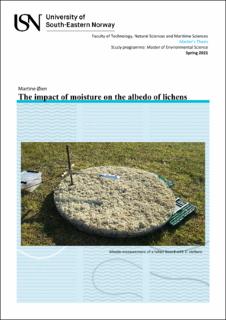| dc.description.abstract | Lichens cover about 8% of the Earth’s land surface. They are an important forage for reindeer, but they also have an impact on the microclimate of their surroundings. Lichens have a relatively high albedo, giving them a cooling effect compared to other vegetation. Lichens also work as an insulating layer for the surface underneath them, and are important for the thawing depth in areas with permafrost. Previous research has shown that the surface albedo of the lichens is affected by several factors such as colour and structure, sunlight, solar zenith angle, and season and time of the day. However, it is not yet clear if moisture has an impact on the albedo of lichens.
Therefore, this study focuses on the effect moisture has on the albedo of lichens, both in an idealised field study and in natural lichen heaths, and on the question if there is a difference in water absorption and drying between different lichen species. Wooden boards covered with lichens were used for the albedo measurements. One lichen board was watered, while the other board was used as the control and was kept dry. Aluminium trays with the lichen species C. islandica, C. stellaris and F. nivalis were used for the drying experiment.
Both the field study and the analysis of a natural lichen heath show that the albedo of C. stellaris increases with enhanced humidity. When C. stellaris became wet its albedo increased with 0.025. Though, it was more difficult to see a difference in albedo in natural lichen heath after a rain shower as other natural factors also affected the measurements.
Colour and structure of different lichen species can affect their ability to absorb water and their drying rate. In this study, the lichen species C. stellaris with thinner branches absorbed over 40% more water than the lichen species C. islandica and F. nivalis with thicker branches. C. stellaris also dried faster, but after some time the moisture content of all the lichen species was similar. Colour did not seem to have an impact on drying. | |
